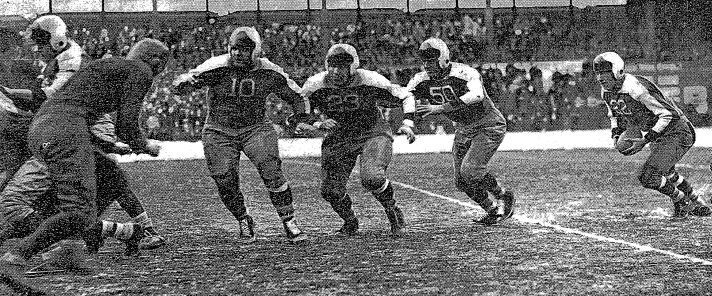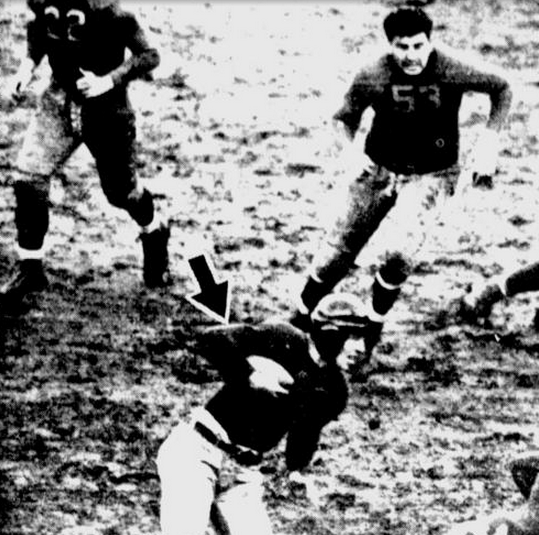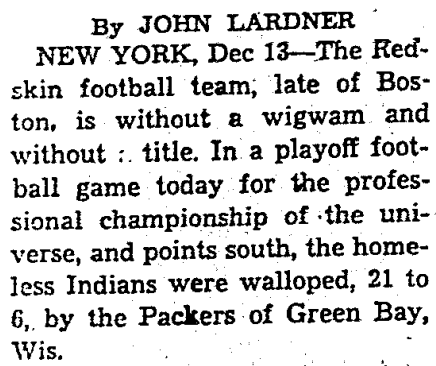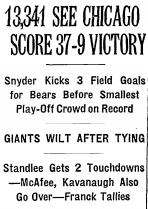Before 16-game seasons and 12-team playoff fields, the NFL played its championship game in the second or third week of December. Not much survives from those battles in the ’30s and ’40s, but there are a few clips available on YouTube. Here’s what I’ve found — from 1934, ’36, ’39 and ’41.
DEC. 9, 1934: GIANTS 30, BEARS 13
This was the celebrated Sneakers Game, so named because the Giants switched to “basketball shoes” (as they were called) in the second half to get better traction on an icy field. They then exploded for 27 points in the fourth quarter to ruin the Bears’ perfect season and keep them from winning a record-tying third straight title.
(It’s still the most points ever scored by a team in the fourth quarter of a playoff game. The ’92 Eagles are next with 26 vs. the Saints in this 36-20 win.)
We begin our film festival with back-to-back runs by the great Bronko Nagurski. Note the Bears are lined up in the T formation, with the quarterback taking the snap directly from center. They were only NFL club using the T in 1934. Everybody else opted for some variation of the single wing. Note also, on the first play, the man-in-motion flashing across the screen. That had been incorporated into the offense, too.
One more tackle-busting Nagurski run. What’s interesting about this play is that the Bears are in the single wing. They mixed it up, in other words — which must have been a nightmare for opposing defenses. Watch for the official slipping and falling at the end of the clip. The field was treacherous in spots.
Here’s a photo of Giants quarterback Ed Danowski (22) getting ready to crack the line. As you can see, he and his blockers are wearing sneakers, which were borrowed from nearby Manhattan College and rushed to the Polo Grounds by locker-room attendant Abe Cohen:
After the footwear change, it was all over for Chicago. The sneaks didn’t just give the Giants better footing, they enabled them to cut more sharply than the Bears could. Hall of Fame fullback Ken Strong scored the final two New York touchdowns — the first over the right side, the second up the middle. In the last part of the clip, he touches the ball down in the end zone, just like in the old days. (Thus the term “touchdown.”)
“Strong had been removed from the game in the first half with his left leg twisted,” Arthur Daley of The New York Times wrote. “He appeared out of it. But he came back in the second, apparently none the worse for wear.”
DEC. 13, 1936: PACKERS 21, REDSKINS 6
The ’36 title game should have been played in Boston, home of the Eastern champion Redskins. But the team didn’t draw well, so owner George Preston Marshall moved the game to New York’s Polo Grounds. (The next season, the franchise was in Washington.)
You’ll love the opening kickoff. According to the Milwaukee Sentinel, the Green Bay returner being picked up, carried back and slammed down is George Sauer (whose son, George Jr., starred for the Jets in Super Bowl III with eight catches for 133 yards, both game highs). Today, no doubt, Boston would have been hit with a personal-foul penalty.
The Packers led 7-6 at halftime thanks to this Hall of Famer-to-Hall of Famer heave from Arnie Herber to Don Hutson, good for a 48-yard touchdown:
Early in the second half Green Bay began to break it open. From the Sentinel: “Herber sent a long aerial down the field which Johnny Blood [another Hall of Famer] caught for a 51-yard gain, Don Irwin nailing him on the 9-yard line. After being halted three straight times on running plays, Herber found [end Milt] Gantenbein alone over the goal line and pegged one right in his arms for a touchdown.”
As the clip shows, Herber dropped back quite a ways before throwing the ball to Blood — 10 or 11 yards by my count. This was to give Johnny time to get downfield, but it’s also an indication of how unreliable pass protection was in that era. Linemen couldn’t use their hands yet, remember, and the concept of the pocket was still years off. (Plus, it was two years before there was a penalty for roughing the passer. Once the ball was released, the defense could pretty much whatever it wanted to the quarterback until the play was whistled dead.)
I’d be remiss if I didn’t insert this last screen shot. It’s of the Packers’ Lou Gordon — No. 53 — running around without a helmet. In 1936 headgear was still optional.
I’d also be shirking my responsibility if I didn’t include the lead paragraph of the game story that ran in the Boston Globe. It was written by John Lardner — Ring’s son — then 24 and working for the New York Herald Tribune. Can you believe it? The Globe didn’t even staff the game (probably because Redskins were abandoning the city). Imagine the Los Angeles Times not covering Super Bowls XXXIV and XXXVI because the Rams had forsaken L.A.
“. . . championship of the universe, and points south.” Classic.
DEC. 10, 1939: PACKERS 27, GIANTS 0
Steve Owen, the Giants’ Hall of Fame coach, missed the game because of his mother’s death. That left the team in the hands of assistant Bo Molenda, a former Packer. The site was switched from Green Bay’s City Stadium to Milwaukee’s larger State Fair Park because this was, after all, the Depression. If a few more tickets could be sold . . . . And indeed, the crowd of 32,279 produced a gate of over $80,000, a record for an NFL title game. The winning Packers reportedly earned $703.97 each, the losing Giants $455.57.
Green Bay turned it into a rout in the third quarter after Gantenbein (yes, him again) picked off a pass and ran it back to the New York 33. A touchdown — one that made it 17-0 — soon followed. The Sentinel again: “[Quarterback Cecil] Isbell, faking and veering the ball nicely, slipped back, wheeled and passed downfield to [back] Joe Laws, who was all alone to take the ball on the 6 and romp over without a man getting within yards of him.”
Aren’t those goalposts the greatest? They were the new, improved version that moved the posts off the goal line, where they could be an obstruction on running plays. (The goal posts weren’t moved to the back of the end zone until 1974.) The post-TD “celebration,” by the way, is just beautiful. A teammate comes up and . . . shakes Law’s hand.
In the fourth quarter, Packers linebacker Bud Svendsen intercepted another Giants pass and returned it to the New York 15. This time Green Bay turned to trickery. “A double reverse, with [Harry] Jacunski carrying on an end-around, brought the ball to the 1 yards,” the Sentinel reported, “and [fullback Ed] Jankowski pounded over the New York right guard for the score.”
Here’s that sequence – interception/double reverse/short touchdown plunge — that gave the Packers their final points:
DEC. 21, 1941: BEARS 37, GIANTS 9
Once again, the Giants took a licking. Of course, this Bears club — just a year removed from the 73-0 evisceration of the Redskins in the title game — was nigh unbeatable. The game was played two weeks after the attack on Pearl Harbor, which might have had something to do with the disappointing attendance: 13,341.
Behind by four touchdowns in the final quarter, New York ran a gadget play in hopes of getting in a parting shot, but the Bears blew it up. The New York Times’ account:
Just before the end, 9 seconds away, [Steve] Owen inserted Andy Marefos into his lineup. The next play was the one that had worked against the Redskins in their first game with the Giants. Hank Soar rifled a lateral [pass] to Marefos, who was supposed to heave a long one down the field.
Before he could get rid of the ball, the entire Bear team hit him at once. The pigskin popped out of his hand and [end] Ken Kavanaugh picked it up and trotted 42 yards to the end zone.
And then America — and many of these players — went off to war.
Source: pro-football-reference.com





